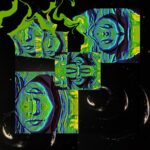The electronic duo A.M. Architect, composed of longtime collaborators Diego Chavez and Daniel Stanush, continues to refine their distinctive fusion of IDM, glitch, and experimental electronica with “Eli,” the latest single from their upcoming album Avenir. This track serves as an intricate sonic tapestry, weaving together delicate synth textures, a dynamic rhythmic foundation, and immersive atmospherics that reinforce the duo’s commitment to pushing the boundaries of electronic music.
At its core, “Eli” is a masterclass in rhythmic precision. The track begins with a gentle, almost ethereal introduction, where faint vocal samples and shimmering pads set an introspective tone. However, as the song unfolds, Chavez and Stanush introduce a complex, evolving beat structure that carefully treads the line between organic fluidity and digital manipulation. The glitch-infused percussive elements skitter and pulse with an unpredictable yet hypnotic cadence, reminiscent of artists like Autechre and Boards of Canada. Each rhythmic layer feels meticulously crafted, interlocking seamlessly to create a sense of forward momentum without overwhelming the delicate soundscape.
The bassline in “Eli” plays a crucial role in anchoring the track’s sonic identity. Instead of relying on a traditional, grounding bass presence, A.M. Architect employs a more textural approach, with low-end frequencies morphing and shifting dynamically throughout the composition. Subtle sidechain compression allows the bass to breathe alongside the beat, reinforcing the fluidity of the arrangement. This unconventional approach gives the song an airy yet substantial feel, further enhancing its cinematic quality.
Synth work is another highlight of “Eli,” showcasing the duo’s ability to blend digital synthesis with warm, analog-inspired timbres. The melodic phrases, often introduced in fragments and loops, create an evolving motif that guides the listener through the track’s shifting soundscapes. Chavez’s expertise in sonic manipulation is evident here, as granular synthesis techniques and processed vocal snippets are employed to build an ever-changing auditory landscape. The synth textures range from lush and atmospheric to brittle and glitch-infused, maintaining a delicate balance between beauty and tension.
Beyond its technical prowess, “Eli” excels in crafting an immersive atmosphere that evokes a sense of nostalgia and introspection. The production is rich with spatial depth, achieved through meticulous use of reverb and delay. This creates an almost dreamlike quality, where every element exists within a vast yet intimate sonic space. The track’s pacing feels organic, with each transition occurring naturally, as if the music itself is breathing.
A.M. Architect’s commitment to merging audio and visual art is evident even in the way “Eli” unfolds. Their use of generative visuals in live performances—reacting in real time to the music—suggests that this track, like their broader work, is meant to be experienced beyond just auditory senses. This interplay between sound and visual media highlights the duo’s forward-thinking approach to electronic music, ensuring that each piece exists not just as a standalone track, but as part of a greater, immersive experience.
With “Eli,” A.M. Architect further cements their place in the experimental electronic music scene. The track is a testament to their ability to craft deeply intricate yet emotionally resonant compositions, blending glitch aesthetics with atmospheric storytelling. As Avenir approaches, “Eli” stands as a shining example of what’s to come—an album that promises to be as forward-thinking as its name suggests.






